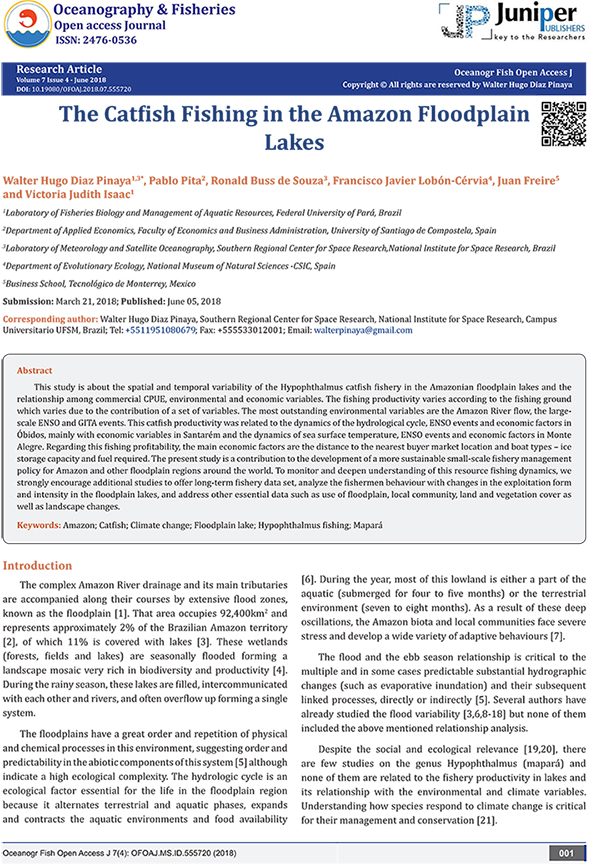Este es el nuevo trabajo, liderado por Walter Pinaya, que acabamos de publicar en la revista Oceanography & Fisheries Open Access Journal sobre la pesca del pez gato Hypophthalmus spp en la llanura de inundación del Amazonas. El acceso al artículo es libre y gratuito:
Archivo de la etiqueta: Journal
La pesca marítima recreativa en Europa
Acaba de publicarse nuestro artículo sobre la pesca marítima recreativa en Europa. La revista es Fish and Fisheries y es de acceso gratuito:
Recreational sea fishing in Europe in a global context—Participation rates, fishing effort, expenditure, and implications for monitoring and assessment
Abstract
Marine recreational fishing (MRF) is a high-participation activity with large economic value and social benefits globally, and it impacts on some fish stocks. Although reporting MRF catches is a European Union legislative requirement, estimates are only available for some countries. Here, data on numbers of fishers, participation rates, days fished, expenditures, and catches of two widely targeted species were synthesized to provide European estimates of MRF and placed in the global context. Uncertainty assessment was not possible due to incomplete knowledge of error distributions; instead, a semi-quantitative bias assessment was made. There were an estimated 8.7 million European recreational sea fishers corresponding to a participation rate of 1.6%. An estimated 77.6 million days were fished, and expenditure was €5.9 billion annually. There were higher participation, numbers of fishers, days fished and expenditure in the Atlantic than the Mediterranean, but the Mediterranean estimates were generally less robust. Comparisons with other regions showed that European MRF participation rates and expenditure were in the mid-range, with higher participation in Oceania and the United States, higher expenditure in the United States, and lower participation and expenditure in South America and Africa. For both northern European sea bass (Dicentrarchus labrax, Moronidae) and western Baltic cod (Gadus morhua, Gadidae) stocks, MRF represented 27% of the total removals. This study highlights the importance of MRF and the need for bespoke, regular and statistically sound data collection to underpin European fisheries management. Solutions are proposed for future MRF data collection in Europe and other regions to support sustainable fisheries management.
Contando peces con ROV, RUV y SCUBA
La revista Marine and Freshwater Research acaba de aceptar la publicación de un artículo sobre una comparativa de censos mediante buceadores, ROV y cámaras de video remoto (RUV).
| Short-term performance of three underwater sampling techniques for assessing differences in the absolute abundances and in the inventories of the coastal fish communities of the Northeast Atlantic Ocean |
| Pablo Pita, Diana Fernández-Márquez y Juan Freire |
| Abstract |
| Comparative works on sampling techniques allow selecting the best methods to study each target fish community. We analysed the structure of a coastal fish community in Galicia (NW Spain) comparing three techniques: diver-based underwater visual census (UVC), remotely operated vehicle (ROV) and remote underwater video (RUV). All the techniques detected abundant and frequent taxa, but divers obtained more precise and complete inventories (80% of identified taxa) than ROV (60%) and RUV (47%); fasters (only 1.4 days to achieve the estimated taxa list), compared to ROV (2.0 days) and RUV (475.7 days); and were more reliable to estimate the abundances of highly mobile, less abundant, less frequent, cryptic and smaller fish. Conversely, RUV obtained the poorest estimates of abundances, and though obtained more replicates (136), obtained more zeros (98%), compared with divers (16 replicates, 64% zeros) and ROV (11 replicates, 75% zeros). Furthermore, the economic cost of the video systems tripled the cost of the diving gears, consequently we recommend using divers to study the coastal fish communities in the shallow waters of the North Atlantic Ocean. However, further research is necessary to explore the full capabilities of video techniques in long-term studies, in great depths or in adverse weather conditions. |
| MF12301 Accepted 02 July 2013 |

